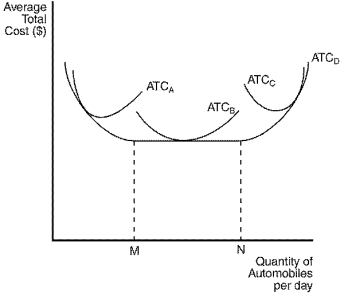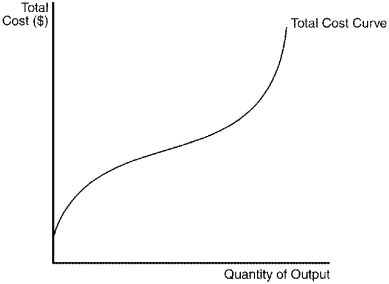A) $25
B) $50
C) $100
D) $200
Correct Answer

verified
Correct Answer
verified
Multiple Choice
Scenario 13-3 Tony is a wheat farmer,but he also spends part of his day teaching guitar lessons.Due to the popularity of his local country western band,Farmer Tony has more students requesting lessons than he has time for if he is to also maintain his farming business.Farmer Tony charges $25 an hour for his guitar lessons.One spring day,he spends 10 hours in his fields planting $130 worth of seeds on his farm.He expects that the seeds he planted will yield $300 worth of wheat. -Refer to Scenario 13-3.Tony's accounting profit equals
A) $-80.
B) $130.
C) $170.
D) $260.
Correct Answer

verified
Correct Answer
verified
True/False
There is general agreement among economists that the long-run time period exceeds one year.
Correct Answer

verified
Correct Answer
verified
Multiple Choice
One assumption that distinguishes short-run cost analysis from long-run cost analysis for a profit-maximizing firm is that in the short run,
A) output is not variable.
B) the number of workers used to produce the firm's product is fixed.
C) the size of the factory is fixed.
D) there are no fixed costs.
Correct Answer

verified
Correct Answer
verified
Multiple Choice
When a factory is operating in the short run,
A) it cannot alter variable costs.
B) total cost and variable cost are usually the same.
C) average fixed cost rises as output increases.
D) it cannot adjust the quantity of fixed inputs.
Correct Answer

verified
Correct Answer
verified
Multiple Choice
In the long run,a firm that produces and sells computers gets to choose
A) how many workers to hire.
B) the size of its factories.
C) which short-run average-total-cost curve to use.
D) All of the above are correct.
Correct Answer

verified
Correct Answer
verified
Multiple Choice
Table 13-3
 -Refer to Table 13-3.What is total output when 1 worker is hired?
-Refer to Table 13-3.What is total output when 1 worker is hired?
A) 30
B) 40
C) 120
D) 160
Correct Answer

verified
Correct Answer
verified
Multiple Choice
Figure 13-9
The figure below depicts average total cost functions for a firm that produces automobiles.  -Refer to Figure 13-9.Which curve represents the long-run average total cost?
-Refer to Figure 13-9.Which curve represents the long-run average total cost?
A) ATCA
B) ATCB
C) ATCC
D) ATCD
Correct Answer

verified
Correct Answer
verified
Multiple Choice
Analyzing the behavior of the firm enhances our understanding of
A) what decisions lie behind the market supply curve.
B) how consumers allocate their income to purchase scarce resources.
C) how financial institutions set interest rates.
D) whether resources are allocated fairly.
Correct Answer

verified
Correct Answer
verified
Multiple Choice
Charles's Car Wash has average variable costs of $2 and average fixed costs of $3 when it produces 100 units of output (car washes) .The firm's total cost is
A) $100.
B) $200.
C) $300.
D) $500.
Correct Answer

verified
Correct Answer
verified
Multiple Choice
Figure 13-5  -Refer to Figure 13-5.Which of the following can be inferred from the figure above?
-Refer to Figure 13-5.Which of the following can be inferred from the figure above?

A) (i) and (ii) only
B) (ii) and (iii) only
C) (i) and (iii) only
D) (ii) only
Correct Answer

verified
Correct Answer
verified
Multiple Choice
The most likely explanation for economies of scale is
A) coordination problems.
B) specialization of labor.
C) increasing marginal cost.
D) decreasing marginal cost.
Correct Answer

verified
Correct Answer
verified
Multiple Choice
Average total cost is equal to
A) output/total cost.
B) total cost - total quantity of output.
C) average variable cost + total fixed cost.
D) total cost/output.
Correct Answer

verified
Correct Answer
verified
True/False
Table 13-1
Listed in the table are the long-run total costs for three different firms.
 -Refer to Table 13-1.Firm A is experiencing economies of scale.
-Refer to Table 13-1.Firm A is experiencing economies of scale.
Correct Answer

verified
Correct Answer
verified
Showing 421 - 434 of 434
Related Exams